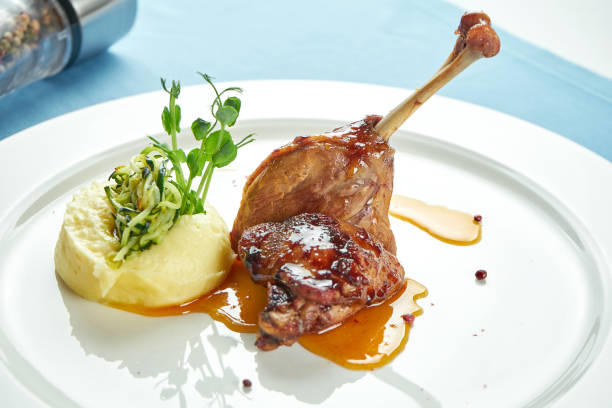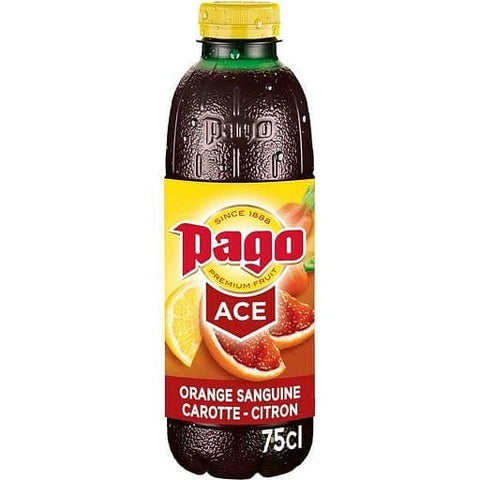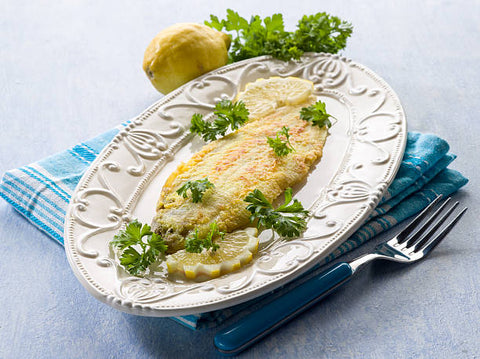Confit de canard is the preparation of duck confit. Confit de canard originated in Gascony, southwest France. where it was traditionally seen to preserve meat for up to several months. Confit comes from the verb confire, which means "to preserve." Confit of duck is also popular in French cuisine as an elegant starter, main course, or ingredient in other dishes.
What is le confit canard?
Confit de canard is a French dish made with salt-cured duck meat and then slow-cooked in its fat. The name comes from the French verb confire, which means "to preserve."
Confit de canard is a specialty of the southwest of France, particularly Gascony. It was introduced to Gascony by the Romans to preserve meat before refrigeration was invented. The process consists of rubbing the meat with salt then cooking it in its fat. The process results in a tender and flavorful meat that keeps for months.
French chefs often use Confit de canard to make cassoulet, a hearty casserole with white beans and sausage. The ducks are removed from their fat after being cooked, but the fat itself can be used later to cook or sauté vegetables or other meats and get expert with the help of cooking nytimes website.
What exactly is Confit?
Editors and critics in the food media have been talking about Confit for a long time now — and it's not going anywhere. But what exactly is Confit?
At its most basic definition, Confit is meat that has been cooked and stored in fat. It's a preservation technique used to keep meat fresh longer. Today, we have refrigeration; so many people don't consider this technique necessary. But it tastes good! Here's how to give it a try:
- Start with your favorite meat. Duck legs are most commonly used, but you can also use pork or chicken.
- Salt the meat with plenty of kosher or sea salt.
- Cook the meat at a low temperature (250 degrees Fahrenheit is standard) until it is tender but not falling apart.
- Remove the meat from the cooking liquid, dry it with paper towels, and pack it into jars or other containers. Pour enough fat over the top to cover the meat completely — duck fat, lard, or olive oil is common choices. Store in the fridge for up to 6 months; freeze for longer storage.
The word Confit is also used to refer to other cuts of duck or goose that have been cured and preserved in the seasoned oil. The most popular parts of the duck for this treatment are the legs and wings, but sometimes the neck, gizzard, and liver are also used and give it try by using the recipe of tasteatlas website.
Origin of Confit de Canard
This is a common dish in the southwestern part of France, and it's made with duck. Like many traditional recipes, confit de canard is pretty simple, consisting of just the meat and some herbs. The word Confit means to preserve, and it has been used on meats since medieval times. Confit comes from the Latin verb "conficere," pointing to do or make.
Originally, preservation was done by;
- Salting the meat and sitting for a few days before cooking it slowly at low temperatures.
- This method allowed the meat to be cooked in large batches so that there would be plenty to last through the winter months when fresh meat was not available.
The first recorded use of this cooking technique was in 1859 in Henriette Davidis' "Practical Cookbook." The recipe called for goose legs to be cooked at a low temperature for several hours until tender.
When was confit de canard made?
Confit de canard was traditionally made in the Gascony region of France, in southwest France near the border of Spain. The area is rich with duck and goose farms, and confit de canard is one of the most famous dishes in the region.
The weather in Gascony is often hot and dry, making it ideal for preserving meat. The original confit de canard recipe was created when people wanted to keep meat for long periods without refrigeration.
Confit de canard was originally made by soaking a duck in salt overnight then slowly cooking it in its fat. The fat kept out any moisture or air, which prevented spoilage. The recipe evolved as people experimented with different ingredients and cooking times, but the basic methods remained unchanged.
Confit de Canard potatoes
A classic confit de canard is accompanied by a mound of Pommes paradise, essentially French fried potatoes cooked in duck fat. This is a simply irresistible and wonderfully rich dish, especially when served with a light red wine such as a Cabernet Franc from the Loire Valley.
- Melt the butter in a pan over medium heat, and add the sliced shallots. Fry them until they turn golden brown and caramelized. Add the garlic, and cook for 30 seconds more. Remove from heat, and set aside.
- Place the sliced potatoes in a large bowl of cold water to remove excess starch. Drain well and pat dry with paper towels.
- In a large saucepan or deep fryer, heat the duck fat to 325°F (155°C). Fry the potatoes in batches until they are soft but not browned. Remove from oil and drain on paper towels.
- Increase temperature to 375°F (190°C), and fry the potatoes again until golden brown, about 3 minutes per batch. Sprinkle with salt while frying if desired. Drain on paper towels to absorb excess oil.
Cooking Confit de Canard
Confit de canard is a French delicacy made from salt-cured duck legs and then cooked and preserved in duck fat.
Confit involves pre-cooking the meat then preserving it in fat, most commonly duck or goose fat. The word "confit" means "to preserve," which is exactly what this cooking method does. The low cooking temperature combined with the salt curing and the fat preservation allows the meat to be kept in a cool, dry place for several months.
Although confit de canard is typically served as an appetizer or starter course, it can also be used as an ingredient in other dishes like cassoulet and the main course dish served with vegetables or salad.
The process involves;
- Marinating and seasoning the meat, then cooking it in its fat at a low temperature
- The meat is then immersed in that same fat, which acts as a seal against oxygen and bacteria while it, is stored.
- Traditional French duck confit uses salt as a preservative and can be kept for six months.

Confit is a healthy way of cooking
Confit is a method of cooking that involves cooking something, usually meat, slowly in fat, at a low temperature, for a long time. This allows the food to preserve in the fat as well as cooked. The result is tender and succulent meat that melts in your mouth. It's delicious!
In general, Confit is not considered a very healthy way of cooking since it does involve putting a lot of fat into your body. So if you're watching your cholesterol or trying to cut back on fat intake, Confit may not be the best option for you.
On the other hand, if you're watching your weight or trying to eat healthier foods, Confit can be a good option. The slow cooking process requires less oil than deep frying and results in moist, tender meat with minimal added fat.
Heating Confit de Canard
There are a few different ways to reheat Confit de canard, depending on what kind of texture and flavor you're looking for.
Directions for reheating Confit de canard:
- Preheat the oven to 325 °F (163 °C).
- Remove the duck legs from the packaging and place them skin-side up in a roasting pan or baking dish.
- Cover the roasting pan or baking dish with aluminum foil.
- Place the confit de canard in the oven for 10–15 minutes until it is warmed through.
- Remove the pan from the oven, being careful not to burn yourself with steam or hot grease escaping from under the foil.
- Carefully remove the foil to avoid getting burned by steam. If desired, drizzle with additional duck fat before serving.
To serve - Remove confit de canard from the refrigerator one hour before serving time. Preheat oven to 250ºC/475ºF/Gas Mark 9. Place duck pieces on an oven tray skin side up and cover each breast with a little cooking fat (reserved from cooking). Please place in the preheated oven for about 10 minutes or until the skin is crisp and has turned golden brown (be careful not to burn it).
Serving Confit de Canard
Serving confit de canard can be done in many ways. It is commonly served as an appetizer or main course dish. However, it can also be used as an ingredient, in other words.
- This dish is often served with potatoes cooked in duck fat and a green salad. If you want to be super fancy and help it as they do in the South West of France, then you can also add some foie gras on top. The combination of flavors is simply divine!
- Confit de canard is often served as cassoulet or another bean casserole. Still, it's also delicious served on its own with something simple like boiled potatoes or even just some crusty bread to mop up the delicious juices.
- Confit de canard is usually served cold or at room temperature and is often eaten as part of a salad. It also sometimes does warm, but this is rare. The dish is sometimes served with a side of potato puree, which contrasts the rich duck meat nicely.
- Confit de canard is often paired with Sauvignon Blanc wine but maybe paired with several other light wines, such as Riesling or Chenin Blanc.
Flavors which go well with duck
- Duck goes well with citrus fruits, like oranges, limes, and lemons. You can use the fruit in a marinade or glaze or squeeze them over your cooked duck. Other fruits that go well with duck include plums, pomegranates, figs, cherries, and grapes.
- Duck also goes well with starches. Try serving your duck with rice pilaf, couscous, or wild rice. For a lighter meal, serve it with potatoes or sweet potatoes. Root vegetables are another good choice; try mashing turnips or parsnips to serve on the side.
For a simple but elegant meal, roast sliced apples with your duck. Or make an apple sauce to serve alongside it. Apples and duck are also both used in many dishes'
A duck is a slice of relatively fatty meat. Fatty foods benefit from the contrast to acidity and bitterness, so sweet sauces are often paired with duck. Sweetness and richness can be further balanced with fresh herbs and citrus, common duck pairings.
Sauces for Confit de canard
The classic sauces for Confit de canard are:
- Ganache (a thick, rich sauce made of chocolate, heavy cream, and butter)
- Caramel sauce (a smooth, luscious sauce made of water, sugar, and butter)
- Poivre (a peppery sauce made of pepper, shallots and cognac)
- Aioli (a garlic-flavored emulsion made of egg yolks, oil, and lemon juice)
The preparation methods for these sauces are as follows:
- To make the ganache:
- Combine water and chocolate in a saucepan and heat over medium-low heat until the chocolate has melted.
- Add heavy cream and butter to the mixture.
- Stir until smooth.
- Remove from heat.
- To make the caramel sauce:
- Combine water and sugar in a pan.
- Heat over low heat until it reaches a caramel color.
- Add butter to the mixture.
- Stir until smooth.
- Remove from heat.
- To make Poivre:
- Combine pepper and shallots in a bowl.
- Add Cognac to the mixture. Stir until smooth.
- Remove from heat. Combine egg yolks with oil in a bowl until it forms an emulsion to make the aioli. Then add lemon juice to the mixture and stir until smooth and look at preparations methods at en Wikipedia website.
So, Confit de canard is one of the most famous dishes of Gascony in southwestern France. The region is known for its excellent foie gras and other duck products, but confit de canard is especially cherished. After Sarlat, a town in Gascony, it's often served with potatoes sauteed in duck fat (or goose fat) called Pommes sarladaises.




